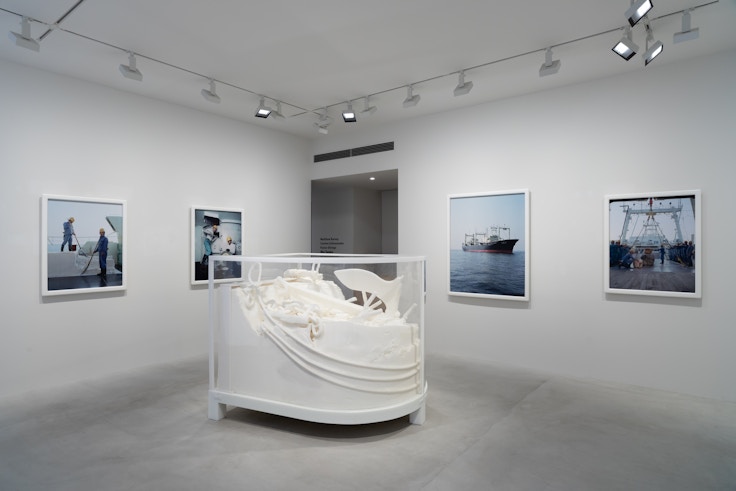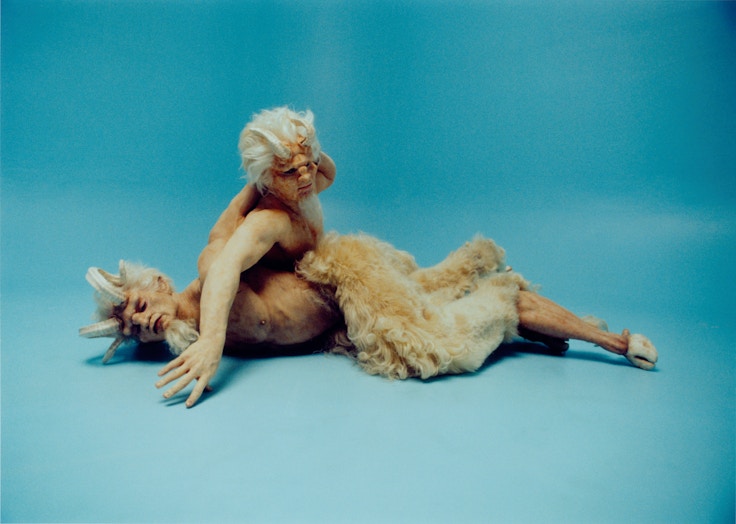Interview of Matthew Barney(MB) and Allyson Spellacy(AS)


AS: Drawing Restraint as a project began in the late 1980s with a basic set of limits: restrain movement while attempting to mark-make within a choreographed and physical facility. Almost from its inception, Drawing Restraint began to expand on narrative, and from there sculpture, photography, and scripted cinema became more elaborate, the most ambitious of which is DRAWING RESTRAINT 9, set entirely in Japan, filmed at Nagasaki Bay in 2005.
Could you speak to the initial impetus to make DRAWING RESTRAINT 9 in Japan with a full cast and crew and as a feature film?
MB: I was invited to make an exhibition in Japan and started making site visits to Kanazawa and traveling around a bit, thinking about what I would do. The idea of making a Drawing Restraint grew out of a discussion I was having with Yuko Hasegawa, who was curating the show at 21st Century Museum of Contemporary Art, about making a Drawing Restraint survey. To be honest, I don't really remember which idea came first—the idea to make a Drawing Restraint exhibition or the idea to go to Japan and make a Drawing Restraint action. I had just finished DE LAMA LAMINA in Brazil, and I felt like I was confronted with a similar problem of working within a culture that’s not mine, a culture with which I have less of a kind of direct connection.
AS: It wasn’t that you were thinking specifically of Japan, until it came about through Yuko Hasagawa’s invitation?
MB: Well, so too was there an invitation in Brazil. Musician Arto Lindsay, for years, kept saying, You have to come to Carnival, you have to see this, come down, we’ll do something—so eventually I did. In that sense, I think they are similar.
AS: You mean in terms of presenting a particular situation within which you have to navigate, whether it’s South America or Japan? In terms of the limitations and challenges to develop a project there?
MB: Yes, my mode of working, at that time particularly, was largely to do with place, a site-specific context and working out from there, toward a narrative. And so, on a number of levels, it felt quite challenging to make a work like that in Japan, from the production standpoint, from the cultural standpoint. So much of the work I had done before, in CREMASTER, for example, even in locations that were not home to me, there was a familiarity with the kind of the Western sensibility, and it was quite easy for me to draw on, you know, a more personal experience.
AS: In CREMASTER you’re still directing the narrative; you’re essentially in control of the story, and the film. When you get to DRAWING RESTRAINT 9, where do you find your own story, given the complexity of reconciling your aesthetic language within a shared other culture?
MB: Just before DRAWING RESTRAINT 9, I had done a kind of takeover of a cinema in Brixton [a district in London, Ritzy Cinema] and there we cast a five-ton petroleum jelly form in the lobby. That casting was made with the intention of it collapsing under its own weight. It was a difficult thing to calculate at that scale, and the casting literally obliterated the lobby. I mean it really couldn’t contain or support its own weight, so as soon as the walls of the mold came off, the form just expanded and went from wall to wall in the cinema. We ended up having to use an alternative entrance just to get people into the cinema to see the films. So, on some level it was a kind of a failure of an installation, but it was exciting—very exciting to me as a material problem.
When I was traveling in Japan and looking around, that was on my mind, and as I started exploring the whaling industry and looking more into the kind of material problems that whalers are faced with, I started conflating those two conditions. The body of a whale on the flensing deck of a ship, once you open up the skin, there’s all of this mass and weight—the blubber has to be dealt with. And so a factory ship where a whale body is being processed out on the ocean—all of the equipment installed on the deck is designed to deal with that problem. That was the first condition of DRAWING RESTRAINT 9—to make a large petroleum jelly casting at sea, on the flensing deck, and use the whaling equipment on board to deal with that material.



AS: I imagine the bureaucracy around the Nisshin Maru ship is pretty intense—how did that become possible?
MB: I did it together with Yuko Hasegawa, and there were many meetings and many rejections from the whaling association, and we just kept presenting it from slightly different angles, and suddenly an opportunity opened up. I have to say, in retrospect, it was surprising that we were able to pull that off. It probably took a year and a half or something like that. I remember at the time thinking that so much of the preproduction had been devoted to that kind of bureaucratic situation that it was starting to affect the film—which was frustrating, but ultimately really worth waiting for.
AS: Back to Brixton: I see parallels in how you disrupt access to the cinema based on the unruliness of the sculpture and what’s taking place on the Nisshin Maru too, you know?
Yeah, that cinema installation was made during the time period of the CREMASTER Cycle survey. It was a project with Artangel, along with a presentation of the five films at the Ritzy Cinema in London, so it was truly about presenting the Cycle, but it was also about trying to create a character that I thought was very present in the Cycle film narratives, but absent from the sculpture. And that would be the character of entropy—I wanted to make a piece that was more nonobjective—to be more or less formless in its demolded state. There’s an aspect to CREMASTER that functions that way for me—although it crystallizes into these five discrete narratives, the work itself is more formless, and at that point in time I felt it was important to express that sculpturally. After watching the Cycle exhibition travel and seeing the way the sculptures were operating in that show—as characters, so to speak—it did feel like there was something missing to me.
AS: It could be said that there’s progressively less restraint throughout the Drawing Restraint series—that the early actions exhibit patent limitation and then develop to multimedia, multi-locational, multi-situational narratives. Does that reflect something of what’s going on in the series?
MB: Well, I think the Drawing Restraint 7 (1993) was obviously a real pivoting point for me—to make a work in the Drawing Restraint language that functioned more narratively and involved other actors. It was less direct in its relationship to mark making within a kind of restraint situation or a condition of restraint. It was carried out narratively and through a set of more psychological questions. So too was DRAWING RESTRAINT 9 in that way, within the kind of filmmaking language that I had developed through CREMASTER; I wanted to understand if, in fact, a DRAWING RESTRAINT could be a feature film.

AS: In the meantime, are you considering future Drawing Restraints? Or is this occupying all of your creative thought?
MB: I had made Drawing Restraint 8, which was a sequence of erotic drawings that were on some level a kind of development for DRAWING RESTRAINT 9, although I don’t think I realized it at the time. That would have been 2003, and so it had been some years since the DRAWING RESTRAINT 7 production. I was definitely in the mood to make DRAWING RESTRAINTs but waited until the feature film was complete before making a kind of flurry of them during the tour of the Drawing Restraint survey show.
AS: Including performing one in each venue: Kanazawa, Seoul, and San Francisco ...(*1)
MB: That’s right.
AS: I recently watched DRAWING RESTRAINT 9 again—what a pleasure. In a way the film feels rigid because it’s built around singular but connected Japanese ceremonies: food preparation, traditional clothing, tea ceremony. My own experience in Japan is there’s a real rigor to how those practices unfold.


The ritual-driven narrative feels overwhelming because it’s impossible to sustain, and I’m wondering if this is intended conceptually, or is it a byproduct of the kind of projects that you’re describing?
MB: In that culture there are such great examples of how action can be imbued into form through ritual, and so too can belief be invested into form, and I find that very interesting. I’ve always looked for ways of bringing narrative into form and I think that ritualized action is often a useful way of doing that, and one that I’ve certainly used over the years. However, I think the general approach I’ve made with narrative or site is that these are temporary conditions for the work, and that if you consider the work as a kind of guest, the guest needs a host body, and that’s a temporary relationship. The work needs to develop and it needs to move on and find a new location and a new narrative, a new site, and so DRAWING RESTRAINT 9 is in many ways about that condition, about the temporary nature of that relationship.
AS: Like the film’s climax, where the two guest characters morph into whales and are released to the sea.
So, if you’re pushing action into form and then responding to how you capture that form, do you then perform action in response to how you documented that action in the past?
MB: I think with experience one becomes more economical. When I go into a moving-image work now, I go knowing what I need photographically out of it. For example, when a set or a situation is being built, I’m thinking about where the camera is going to be placed. I didn’t do that when I was younger: I constructed sets in the round, built the entire space and decided where to put the camera. Before, I didn’t have the experience to think about it in that way.
AS: You are now producing less photography as artwork. When did that shift come about?
MB: I think the easiest way to talk about it is that I felt like the sculpture and the moving-image work, the drawing, the performance—those forms were all developing and existing with a similar kind of agency, in that they had in themselves a kind of quality of, let’s say, a kind of resistance to the world, and in part their content has to do with the process of how they were made. I never felt that way about the photography. I think the photography felt like it had been stolen from these other forms. So I always had a kind of troubled relationship to it, although at times it felt very important to me. I even resented it because it was so easily captured.



















